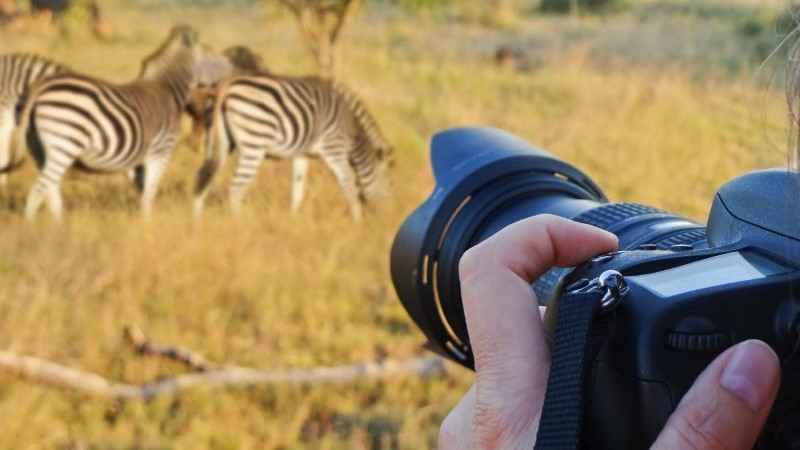Photography Safaris in Kenya

A Journey of Unparalleled Beauty and Adventure.
Kenya is a premier destination for photography safaris, offering unparalleled opportunities to capture the raw beauty and power of Africa's iconic wildlife. From the sweeping savannas of the Masai Mara to the lush forests of Samburu, this East African nation is a photographer's dream. The diversity of landscapes and abundant wildlife provide endless photographic possibilities, making Kenya a must-visit destination for nature and wildlife photographers.
The Great Wildebeest Migration.
One of the biggest draws is the annual Great Wildebeest Migration, where millions of wildebeests and zebras traverse the Mara River in search of greener pastures. Witnessing this natural spectacle and immortalizing it through the lens is a bucket-list experience for many. The Masai Mara National Reserve, which straddles the Mara River, is the prime location to photograph this dramatic event, with the best viewing typically between July and October. The migration is a veritable nirvana, providing unparalleled opportunities to capture breathtaking images that will leave a lasting impression.
Diverse Landscapes and Wildlife.
Beyond the migration, Kenya's diverse landscapes and abundant wildlife provide endless photographic possibilities. In the Samburu National Reserve, you can capture the unique "Special Five" species—reticulated giraffe, Grevy's zebra, gerenuk, Somali ostrich, and Beisa oryx. Meanwhile, Amboseli National Park offers stunning views of Mount Kilimanjaro as a backdrop to herds of elephants, lions, and other big game. The park's unique ecosystem, characterized by dry savannas and acacia trees, provides a rich tapestry of colors and textures that photographers can exploit. Lake Nakuru National Park is also a destination for photography safaris in Kenya, offering unparalleled opportunities to capture stunning images of diverse wildlife and landscapes. The park is known for its large flocks of flamingos that feed on the lake's algae, providing a breathtaking pink backdrop for photographers.
Planning Your Photography Safari. Camera Bag Essentials
When planning a photography safari in Kenya, it's essential to choose the right equipment and be prepared for the challenges of the environment. Renting lenses can be a cost-effective option for those who don't want to invest in heavy, expensive gear. For a successful photography safari in Kenya, it's advisable to pack the following essentials:
Telephoto Lens: A lens with a focal length of 300-500mm is ideal for capturing wildlife from a distance.
Wide-Angle Lens: A wide-angle lens can help capture the vast landscapes and group shots of animals.
Flash: A flash can be useful for filling in shadows and capturing details in low-light conditions.
Tripod: A sturdy tripod is necessary for capturing sharp images, especially in low-light conditions.
Camera Body: A camera body that is durable and reliable is crucial for the rigors of a safari.
Memory Cards: Plenty of memory cards to store your images.
Power Bank: A power bank to keep your devices charged throughout the day.
Dust and Water Protection: Dust and water protection for your camera and lenses to ensure they remain functional.
What is the best time for photography safari?
The best time for a photography safari in Kenya largely depends on the lighting conditions and the behavior of the wildlife, both of which play a crucial role in capturing stunning images. The most favourable times for safari photography are the "golden hours" surrounding sunrise and sunset. During these periods, the soft, warm light creates a magical ambiance, and the low angle of the sun casts beautiful, long shadows, adding depth and dimension to your shots. The early morning and late afternoon are when wildlife is often most active, offering prime opportunities to capture animals in action, whether it’s predators on the hunt or herbivores and birds engaging in their daily routines. Kenya offers a year-round safari experience, but the peak seasons for wildlife viewing and photography are generally considered to be during the great migration season, which occurs between July and October. This is when over 1.2 million wildebeest migrate from Serengeti National Park to Kenya’s Masai Mara National Park. The arrival of the migratory herds corresponds with the best weather along the Kenya coastal strip, making it an ideal time for a safari and beach holiday combo.
Conclusion.
Kenya's photography safaris offer a unique blend of adventure, wildlife, and breathtaking landscapes. With its diverse ecosystems, abundant wildlife, and unparalleled photographic opportunities, Kenya is a dream destination for nature and wildlife photographers. By planning ahead and choosing the right safari experience, you can return home with stunning images that immortalize the majesty of the African wilds. Whether you are a seasoned photographer or an amateur enthusiast, Kenya's photography safaris are an experience that will leave you with memories to cherish for a lifetime.
